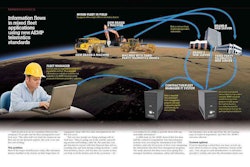Twenty-four percent of the nation’s major metropolitan roads – interstates, freeways and other critical local routes – have pavements in poor condition, resulting in rough rides and costing the average urban motorist $402 annually in additional vehicle operating costs, according to a new report released on Sept. 22 by TRIP, a national transportation research group.
TRIP’s report, “Hold the Wheel Steady: America’s Roughest Rides and Strategies to Make our Roads Smoother,” identifies the top 20 urban regions (500,000+ population) with the greatest share of major roads and highways with pavements in poor condition, and the top-twenty urban regions where motorists pay the highest vehicle operating cost (VOC) because of roads in poor condition.
Driving on roads in disrepair increases consumer costs by accelerating vehicle deterioration and depreciation, increasing the frequency of needed maintenance, and increasing fuel consumption and tire wear.
The top 20 urban regions with roads in “poor” condition (source: TRIP):
| Rank | Urban Area | Pct. Poor |
| 1 | San Jose, California | 64% |
| 2 | Los Angeles, California | 63% |
| 3 | Honolulu, Hawaii | 62% |
| 4 | Concord, California | 58% |
| 5 | San Francisco-Oakland, California | 58% |
| 6 | New Orleans, Louisiana | 55% |
| 7 | New York-Newark, NY/NJ | 53% |
| 8 | San Diego, California | 50% |
| 9 | Indio-Palm Springs, California | 47% |
| 10 | Baltimore, Maryland | 46% |
| 11 | Kansas City, Missouri / Kansas | 45% |
| 12 | Riverside-San Bernardino, California | 44% |
| 13 | Oklahoma City, Oklahoma | 42% |
| 14 | Sacramento, California | 42% |
| 15 | Omaha, Nebraska | 42% |
| 16 | San Antonio, Texas | 39% |
| 17 | Detroit, Michigan | 38% |
| 18 | Philadelphia, Pennsylvania | 37% |
| 19 | Tulsa, Oklahoma | 36% |
| 20 | Dallas-Fort Worth, Texas | 34% |
The TRIP report also provides urban pavement conditions and extra vehicle operating costs for urban regions with population between 250,000 and 500,000 residents. Additional pavement condition and vehicle operating costs can be found in the full report and appendices.
“With state and local governments facing looming budget deficits and without a long-term federal surface transportation program in place, road conditions are projected to get even worse in the future,” said Will Wilkins, TRIP’s executive director. “Repairing rough urban roads could ease the burden on drivers and provide a smoother ride while creating jobs and boosting the economy.”
The FHWA found that every $1 billion invested in highway construction would support approximately 27,800 jobs, including approximately 9,500 in the construction sector, approximately 4,300 jobs in industries supporting the construction sector, and approximately 14,000 other jobs induced in non-construction related sectors of the economy.
According to the U.S. DOT, through 2025, the U.S. faces a $189 billion shortfall in the cost to maintain urban roadways in their current condition and a $375 billion shortfall in the cost to make significant improvements to urban roadways. State transportation funding is threatened by the continuing fiscal crisis in state budgets, which in fiscal year 2010 prompted a $74.4 billion reduction in overall state spending. States’ financial needs continue to far surpass expenditures, with the National Governors Association projecting total state budget shortfalls for 2010 – 2011 of more than $127 billion.
The lack of a long-term federal surface transportation program, which would provide a predictable level of federal funding, is impeding the ability of states to plan and implement large-scale rehabilitation and reconstruction projects. Congress is currently debating over the long-range federal surface transportation program. The current program, the Safe, Accountable, Flexible, and Efficient Transportation Equity Act – A Legacy for Users (SAFETEA-LU), was originally scheduled to expire on September 30, 2009. Following five short-term extensions by Congress, the legislation now expires on Dec. 31, 2010.
Highway preservation projects provide significant economic benefits by improving travel speeds, capacity, load-carrying abilities and safety, and reducing operating costs for people and businesses.
Roadway repairs also extend the service life of a road, highway or bridge, which saves money by either postponing or eliminating the need for more expensive future repairs.
According to the TRIP report, transportation agencies can reduce pavement life cycle costs by adopting a pavement preservation approach that emphasizes making early initial repairs to pavement surfaces while they are still in good condition and the use of higher-quality paving materials, which reduces the cost of keeping roads smooth by delaying the need for costly reconstruction.












